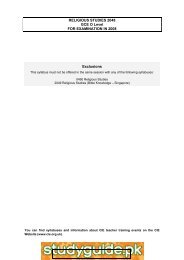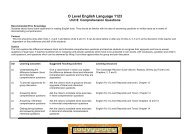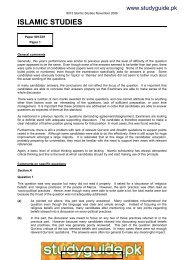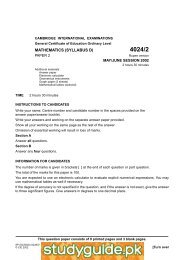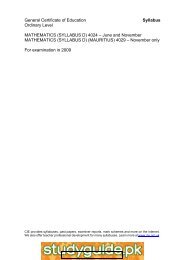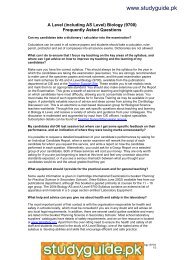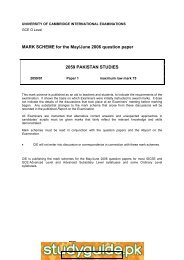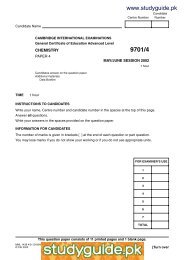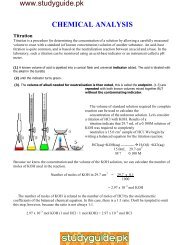A Level Sociology 9699 - StudyGuide.PK
A Level Sociology 9699 - StudyGuide.PK
A Level Sociology 9699 - StudyGuide.PK
You also want an ePaper? Increase the reach of your titles
YUMPU automatically turns print PDFs into web optimized ePapers that Google loves.
www.studyguide.pk<br />
AO Learning outcomes Suggested Teaching activities Learning resources<br />
conservative force or a dynamic for change in the example under<br />
review. Link the presentations to a summary of the main<br />
sociological perspectives on religion and its relationship to social<br />
change.<br />
For detailed information about Weber's<br />
theory of religion, see:<br />
www.ne.jp/asahi/moriyuki/abukuma<br />
6.2 Religious movements<br />
• Distinguish between cults,<br />
sects, denominations and<br />
churches.<br />
• Assess the secularisation<br />
thesis.<br />
• Discuss the relationships<br />
between religious<br />
fundamentalism, modernity<br />
and post-modernity.<br />
Begin by defining the different forms of religious organisations,<br />
including churches, denominations, sects and cults. Discuss the<br />
reasons for the growth of sects and new religious movements.<br />
Move on to the secularisation debate, reviewing the evidence for<br />
and against the idea that religious influence is declining in modern<br />
industrial societies. Point out the difficulty of defining religion and<br />
the problems involved in measuring religious belief and<br />
commitment. Consider examples of religious revivalism, such as<br />
new wave Christianity in the USA and western Europe.<br />
Use examples to illustrate the meaning of religious<br />
fundamentalism and consider the reasons for the apparent<br />
resurgence in this form of religious practice in both Christianity<br />
and Islam. Link to the discussion about the transition from<br />
modernity to post-modernity and the processes of globalisation in<br />
particular.<br />
Class activity<br />
Invite the class to design a simple survey that could be used for<br />
assessing the extent of religiosity in their society. Discuss the<br />
potential problems in designing the survey and formulating<br />
appropriate questions. Link to an assessment of the strengths and<br />
limitations of the empirical data used by sociologists on both sides<br />
of the secularisation debate.<br />
Barnard, A. et al, pp177-180,<br />
distinguishes between church,<br />
denomination and sect. The arguments<br />
for and against the secularisation thesis<br />
are examined on pp181-186<br />
Barnard, A. et al, pp186-187 discusses<br />
religious fundamentalism and its links with<br />
post-modernity.<br />
Haralambos, pp495-501, provides an<br />
excellent summary of recent contributions<br />
to the <strong>Sociology</strong> of Religion from a postmodernist<br />
perspective.<br />
The Classic Collection video, Eileen<br />
Barker on The Making of a Moonie,<br />
provides an excellent case study for<br />
discussing cults and their relationship to<br />
established religious organisations.<br />
An excellent source for information about<br />
different religious movements is:<br />
http://religiousmovements.lib.virginia.edu/<br />
2<br />
www.xtremepapers.net



